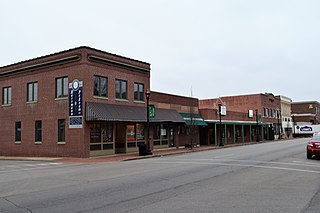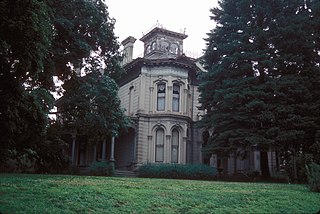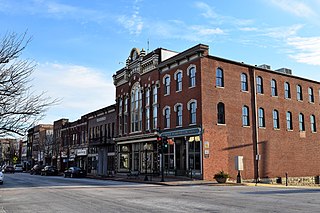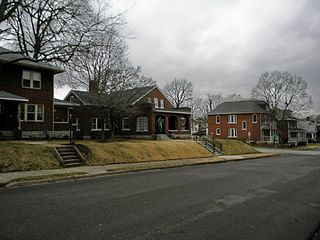
The East Columbia Historic District is a national historic district located at Farmington, St. Francois County, Missouri. The district encompasses 11 contributing buildings in the central business district of Farmington. It developed between about 1879 and 1954, and includes representative examples of Late Victorian, Beaux Arts, and Bungalow / American Craftsman style architecture. Notable buildings include the Tetley Jewelry Store, Andy Hahn Building, Lang and Holler Building, U.S. Post Office, and Henry C. Meyer Building, and T.F. Lockridge Harness Co. Building / Wichman Nash Service.

The Old City Hall, also known as Oxford Flats, is located just north of downtown along a commercial corridor in Davenport, Iowa, United States. It was individually listed on the National Register of Historic Places in 1983. In 2020 it was included as a contributing property in the Davenport Downtown Commercial Historic District.

This is a list of the National Register of Historic Places listings in Jefferson County, Missouri.

The Titusville Historic District is a national historic district that is located in Titusville, Crawford County, Pennsylvania.

Charlottesville and Albemarle County Courthouse Historic District, also known as the Charlottesville Historic District is a national historic district located at Charlottesville, Virginia. The district encompasses the previously listed Albemarle County Courthouse Historic District and includes 269 contributing buildings and 1 contributing object in the city of Charlottesville. It includes the traditional heart of the city's commercial, civic, and religious activities, with early residential development and industrial sites located along the fringe. The commercial core is located along a seven block Downtown Mall designed by Lawrence Halprin (1916-2009). Notable buildings include the Albemarle County Courthouse, Levy Opera House, Number Nothing, Redland Club, Eagle Tavern, United States Post Office and Courts Building (1906), Christ (Episcopal) Church (1895-1898), Beth Israel Synagogue (1882-1903), Holy Comforter Catholic Church (1925), First Methodist Church (1924), McIntire Public Library (1919-1922), and Virginia National Bank (1916). Also located in the district are the separately listed Abell-Gleason House, William H. McGuffey Primary School, Thomas Jonathan Jackson sculpture, Robert Edward Lee sculpture, and Marshall-Rucker-Smith House.

Jefferson Historic District is a national historic district located at Lafayette, Tippecanoe County, Indiana. The district encompasses 161 contributing buildings, 2 contributing sites, and 22 contributing structures in a predominantly residential section of Lafayette. It developed between about 1853 and 1951 and includes representative examples of Italianate, Greek Revival, and Bungalow / American Craftsman style architecture. Notable contributing resources include the Deutsche Evangelische Kirche (1905), Isador Metzger House, Hubert Gilmartin House, B.F. Biggs Pump Factory Building, Deutsche Methodist Kirche (1885), Herman & Mary Fletemeyer House, Mohr House, Warrenberg-Reule Double House, Alfred Gaddis House, Wabash Valley House (1862), Haywood Tag Company Building (1928), and Jefferson High School (1927).

Cabins Historic District is a national historic district located near Novinger, Adair County, Missouri. The district encompasses nine contributing buildings, three contributing sites, four contributing structures, and one contributing object in a relatively isolated area near Novinger. It developed between about 1829 and 1865 and was one of the earliest settlements in the interior of northeast Missouri. It includes five antebellum structures surrounded by forests and farm land. They are the John B. Cain House, the Asa King Collett House, the Ira R. Collett House and its poultry house and summer kitchen. Other notable contributing resources include the Conner Tannery site, the Collett Spring, the site of Fort Clark, the site of Camp Collett, the Collett Cemetery, and Native American burial mounds.

Robidoux Hill Historic District is a national historic district located at St. Joseph, Missouri. The district encompasses 61 contributing buildings in a predominantly residential section of St. Joseph. It developed between about 1865 and 1909, and includes representative examples of Italianate, Second Empire, and Queen Anne style architecture. Located in the district is the separately listed Edmond Jacques Eckel House designed by architect Edmond Jacques Eckel (1845–1934). Other notable buildings include the Lemon House (1871), Donovan House, McKinney House (1887), Inslee House, Jonathan M. Bassett, and U.S. Weather Bureau Building (1909).
Dalton Vocational School Historic District, also known as the Bartlett Agricultural and Vocational School Historic District, is a national historic district located near Dalton, Chariton County, Missouri. The district encompasses nine contributing buildings and one contributing site of an African American agricultural and vocational school that served Chariton and surrounding counties during the first half of the 20th century. Plans for the school were initiated in 1905 and after it opened it developed and operated until 1956. Building at the site include the Bartlett Classroom Building (1938), Busch Building (1909), Principals Cottage, Cafeteria, Machine Shop, two sheds, a barn, and a poultry house, along with 123 acres of property.

Missouri State Capitol Historic District is a national historic district located at Jefferson City, Cole County, Missouri. It encompasses 122 contributing buildings in the central business district of Jefferson City. The district developed between about 1850 and 1950, and includes representative examples of Classical Revival, Late Victorian, Queen Anne, Mission Revival, and Modern Movement style architecture. Located in the district are the separately listed Missouri State Capitol, Lohman's Landing Building, Cole County Historical Society Building, Cole County Courthouse and Jail-Sheriff's House, Missouri Governor's Mansion, and Tergin Apartment Building. Other notable buildings include the St. Peter's Roman Catholic Church complex (1881-1883), Margaret Upshulte House, Broadway State Office Building (1938), Supreme Court of Missouri (1905-1906), U.S. Post Office and Courthouse (1932-1934), Lohman's Opera House, Missouri State Optical, First United Methodist Church (1900), Carnegie Public Library (1901), Temple Beth El (1883), and Joseph and Susie Kolkmeyer House.

Locust Street Historic District is a national historic district located at Washington, Franklin County, Missouri. The district encompasses 123 contributing buildings in a predominantly residential section of Washington. The district developed between about 1839 and 1949, and includes representative examples of Italianate, Queen Anne, Colonial Revival, and Bungalow / American Craftsman style residential architecture. Located in the district is the separately listed Franz Schwarzer House. Other notable buildings include the Lucinda Owens House (1839), Frederich Griese House, Sophia Greiwe House, Presbyterian Church (1916), Hy. Oberhaus House, Gustav Richert Apartment Building, Southern Presbyterian Church/Attucks School (1868), Washington High School (1887), and AME Church

Brehe Farmstead Historic District, also known as the Fairview Stock Farm, is a historic home, farm, and national historic district located at Washington, Franklin County, Missouri. The farmhouse was built about 1869, and is a two-story brick dwelling. The other contributing buildings are the brick smokehouse/ dwelling combination, a frame poultry house (1940s), a large frame granary, a Quonset barn, a small frame milk house, and a large gambrel roofed bank barn with a round ceramic block silo.

Stafford–Olive Historic District is a national historic district located at Washington, Franklin County, Missouri. The district encompasses 140 contributing buildings in a predominantly residential section of Washington. The district developed between about 1858 and 1949, and includes representative examples of Queen Anne, Second Empire, Tudor Revival, Colonial Revival, and Bungalow / American Craftsman style residential architecture. Notable buildings include the Jos. Rumme House, Chas Haupt House, Louis Horn House, F. R. Pelster House, Hydecker House, Stephen Filla House, Chas. Kopp House, Hy. Thias Honse, and William Pace House (1929).

Edina Double Square Historic District is a national historic district located at Edina, Knox County, Missouri. The district encompasses 37 contributing buildings in the central business district of Edina. It developed between about 1865 and 1945 and includes representative examples of Italianate and Streamline Moderne style architecture. Notable contributing buildings include the Public Works Administration funded Knox County Courthouse (1934–1935) designed by William B. Ittner, Bishoff Bakery (1891), Northern Hotel (1860s), Ennis House/Northern Hotel, Edina School and Gymnasium (1915–1916), D. H. Mudd Building, Phillip Linville Building, Tobias J. Lycan Building, Jacob Pugh Building, Albert G. Bostick Building, Knox County Savings Bank, Thomas Burk Buildings, Bank of Edina Building, Joseph F. Biggerstaff Buildings, Stablein Building, and Knox County Public Library.

Old Neighborhoods Historic District is a national historic district located at Lexington, Lafayette County, Missouri. The district encompasses 267 contributing buildings in a predominantly residential section of Lexington. It developed between about 1830 and 1930, and includes representative examples of Late Victorian and Greek Revival style architecture. Located in the district are the separately listed Cumberland Presbyterian Church and Waddell House. Other notable contributing resources include the McGrew House, Schacklett House, Waddell-Pomercy House, Waddell-Young House, First Christian Church, Walter B. Waddell House, Eggleston House, Lafayette Arms, United Methodist Church, Reorganized Church of Jesus Christ of Latter Day Saints, Marquis W. Withers House, John Eggleston House, Christ Church Episcopal, Trinity United Church of Christ, Old German Catholic Church, and Lexington Middle School.
Bonnots Mill Historic District is a national historic district located at Bonnots Mill, Osage County, Missouri. It encompasses 98 contributing buildings in the central business district and surrounding residential sections of Bonnots Mill. The district developed between about 1840 and 1942, and includes representative examples of Bungalow / American Craftsman and I-house architecture. Located in the district is the separately listed Dauphine Hotel. Other notable buildings include the Bonnots Mill School (1889), Henry Dieckriede House, Bonnots Mill United Methodist Church (1915), Bank of Bonnots Mill (1907), Bonnet's Mill Hotel / Krautman's Store, Meyer-Morfeld Milling Company, United States Post Office, St. Louis Parish Church and Rectory (1907), and St. Louis Parish School.

Mt. Pleasant Winery Historic District is a historic winery and national historic district located at Augusta, St. Charles County, Missouri. The district encompasses a frame half-timber house with brick outbuilding ; a brick winery building (1881) with a stone well house (1881); and wine cellars. The winery building measures approximately 24 feet by 62 feet, 6 inches, with a 15 foot by 17 foot extension leading to the wine cellars. The wine cellars feature brick floors and brick barrel vaults supported by stone walls.

Midtown Neighborhood Historic District is a national historic district located at St. Charles, St. Charles County, Missouri. The district encompasses 527 contributing buildings, 7 contributing sites, and 5 contributing objects in a predominantly residential section of St. Charles. It developed between about 1838 and 1959, and includes representative examples of Federal, Greek Revival, Gothic Revival, Italianate, Queen Anne, Romanesque Revival, Folk Victorian, Colonial Revival, Classical Revival, Tudor Revival, and Bungalow / American Craftsman style architecture. Located in the district are the separately listed African Church and Oliver L. and Catherine Link House. Other notable buildings include the St. Charles County Courthouse, Benton School (1896), St. John's A.M.E. Church (1872), Immanuel Lutheran Church (1867), Jefferson Street Presbyterian Church, Fourth Street Market Grocery (1926-1927), West End Grocery and Meat Market, Dr. Ludwell Powell House (1838), Rogers-Ehrhard House, Waye Monument Company and Residence (1889), Meyer House, Kaemmerlen House, and Elsner House.

The White Cloud Historic District is a 41.3 acres (16.7 ha) historic district in White Cloud, Kansas which was listed on the National Register of Historic Places in 1996. It is roughly bounded by Poplar, 6th, Chesnut Sts. and K-7 and included 67 contributing buildings and a contributing site, as well as 15 non-contributing buildings and a non-contributing site.
The Meyers Farmstead Historic District, also known as the Jacob E. and Amanda Meyers Farm and the John B. and Ella Meyers Farm, is an agricultural historic district located in Lisbon, Iowa, United States. It was listed on the National Register of Historic Places in 2021. At the time of its nomination it consisted of six resources, which included two contributing buildings, two contributing structures, and two contributing objects. The historic buildings include a heavy timber frame Pennsylvania banked barn (1870s) and a feeder/hay barn. The historic structures include a combination corn crib/hog house (1880s) and a concrete silo. The contributing objects include a concrete watering trough and water pump and a metal gateway. The farmhouse is also extant but was separated from the rest of the farm buildings when South Jefferson Street was extended in 2002. That separation and the modifications made to it over the years has led to its loss of historical integrity





















